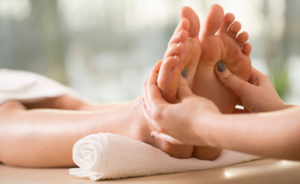Whether you are looking to alleviate your sore feet or just want to improve your circulation, a foot massage can be a great option for you. The right massage can help reduce muscle soreness and joint pain, combat edema, and promote restful sleep.

Performing foot massage is a great way to improve circulation. It can help reduce stress and muscle tension, increase energy, and reduce the risk of injuries.
The circulatory system in the body carries oxygen and nutrients to every part of the body. It is also responsible for removing waste products from the body. A good massage stimulates the lymphatic system, which enables more blood to flow to the muscles. This increased capillarization helps to deliver more oxygen to the muscles.
Another reason to perform a foot massage is to help keep your feet warm. This can help prevent cold feet, which are a symptom of Raynaud’s disease, which causes small arteries in the limbs to narrow.
A foot massage can even help you get a better night’s sleep. It can also be useful if you suffer from a chronic foot condition, such as edema.
For the best results, get a foot massage from a qualified reflexologist. You can also try a footbath with different temperatures, which can boost circulation.
In addition to improving circulation, a foot massage is also beneficial in terms of reducing pain. It can ease tension, reduce fatigue, and speed up the healing process from injury. It can also lessen the risk of future injuries.
Although the benefits of a foot massage are many, it should not be treated as a cure-all. If you have intense foot pain, you should consult with a doctor.
A 10-minute foot massage was shown to have positive effects on heart rate, blood pressure, and mood. A foot massage for four minutes had similar effects.
One study showed that foot massage improved the circulation of water in the foot. Another said that foot massage could stimulate white blood cells, which aid in fighting diseases.
Using foot massages is a great way to reduce muscle soreness and joint pain. This technique can help you heal quickly and prevent future injuries. You can also use it to help you improve your circulation.
Muscle soreness occurs when your muscles become swollen, stiff, and tender. This is a normal reaction to a strenuous workout. It generally goes away in a few days. However, it can be uncomfortable and may affect your ability to sleep.
Muscle soreness is caused by microscopic tears in the muscle fibers. These tears disrupt the calcium homeostasis of the cells, causing inflammation. This inflammation serves as the body’s defense against foreign invaders. During the inflammatory process, inflammatory cells release substances that activate pain receptors.
The cells in the muscles are made up of protein fibers. These fibers can be broken down by high concentrations of calcium. This causes enzymes to break down the cell membranes, which causes inflammation and pain.
Massaging the muscle improves blood flow to the muscle, which helps to reduce metabolic waste buildup. The increased blood flow provides nutrients and oxygen to the cells.
The lymphatic system, which is composed of lymph vessels, removes waste products from the body. During a massage, the lymphatic flow picks up these waste products and transports them back into the bloodstream. This is important for removing excess lactic acid and toxins from the muscles.
The removal of these waste products can reduce muscular fatigue and weakness. They can also increase flexibility and range of motion, allowing the muscles to perform at their highest levels.
A new study has found that a massage can enhance recovery from exercise. Researchers used gene-profiling techniques to examine the chemical changes in muscle cells before and after exercise. They discovered that those who received a Swedish-style massage after a workout had less soreness and pain than those who did not.
During the menstrual cycle, a woman experiences PMS, a set of hormone-related symptoms. These include depression, pain, irritability, and weight gain. Some women have very mild PMS, while others have very severe symptoms.
